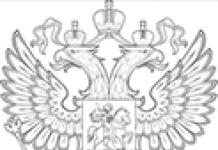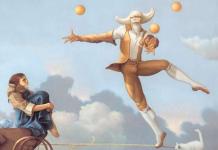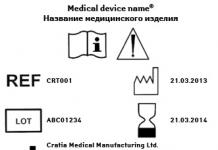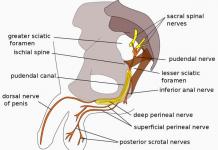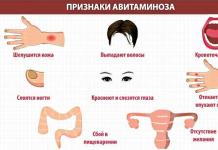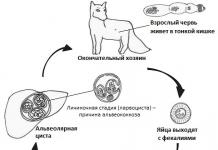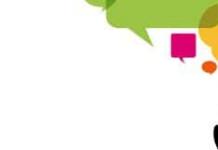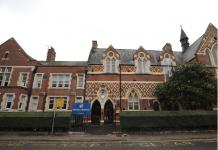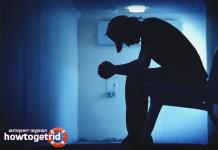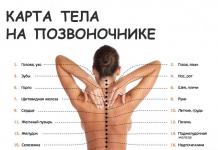But with experience comes the understanding that reflection greatly helps the teacher to control the class, already in the course of the lesson to see what was understood and what was left for revision, that is, "keep an eye on the pulse." Do not forget that reflection is something new that modern pedagogy strives for: to teach not science, but teach to learn. Reflection helps the child not only to understand the path traveled, but also to build a logical chain, systematize the experience gained, and compare his successes with the successes of other students.
In the structure of a lesson that meets the requirements of the Federal State Educational Standard, reflection is compulsory stage of the lesson. Particular emphasis is placed on the reflection of activities, it is proposed to carry out this stage at the end of the lesson. In this case, the teacher plays the role of organizer, and the main characters are the students.
What is reflection?
The dictionaries give a clear definition: reflection is introspection, self-esteem, "looking inside oneself". With regard to lessons, reflection is a stage of the lesson, during which students independently assess their state, their emotions, and the results of their activities.
What is reflection for?
If the child understands:
- why he is studying this topic, how it will be useful to him in the future;
- what goals should be achieved in this particular lesson;
- what contribution he can make to the common cause;
- can he adequately assess his work and the work of his classmates,
... then the learning process becomes much more interesting and easier for both the student and the teacher.
When to conduct?
Reflection can be carried out at any stage of the lesson, as well as following the results of studying the topic, a whole section of the material.
Views
There are several classifications of reflection as a lesson stage. Knowing the classification, it is more convenient for the teacher to vary and combine techniques, including reflection in the lesson plan.
I . By content : symbolic, oral and written.
Symbolic - when a student simply gives a grade using symbols (cards, tokens, gestures, etc.). Oral involves the child's ability to coherently express their thoughts and describe their emotions. Writing is the most difficult and takes the most time. The latter is appropriate at the final stage of studying an entire section of educational material or a large topic.
II ... By the form of activity : collective, group, frontal, individual.
It is in this order that it is more convenient to teach children to this type of work. First - with the whole class, then - in separate groups, then - selectively interview students. This will prepare students for independent work above oneself.
III ... By target :
Emotional
She assesses the mood, emotional perception of the educational material. This is a reflection from the categories "liked / disliked", "interesting / boring", "it was fun / sad".
This type of reflection helps the teacher assess the general mood of the class. The more positive, the better the topic is understood. And vice versa, if there are more conventional "clouds", it means that the lesson seemed boring, difficult, there were difficulties with the perception of the topic. Agree, we are bored and sad when we do not understand something.
How and when to carry it out?
Reflection of mood and emotionality is easy to carry out even with first graders. There are a lot of options: handout cards with emoticons or iconic pictures, showing the thumb (up / down), raising hands, signal cards, etc. It is more convenient to carry out at the end of the next stage of the lesson: after the explanation new topic, after the stage of fixing the topic, etc.
At the beginning of the lesson, emotional reflection is carried out in order to establish contact with the class. You can put on music (choosing a motive that is consistent with the theme), quote a classic, read an emotional poem. After that, you should definitely ask 3-4 students: "What do you feel now? What mood are you in? Etc. First, students (even the smallest ones) get used to assess their state, their emotions, and secondly, they learn to argue their In addition, such reflection will help students to tune in to the perception of the topic.
Reflection of activity
This type of reflection is more convenient to use when checking homework, at the stage of consolidating the material, when defending projects. It helps students to comprehend the types and methods of work, analyze their activity and, of course, identify gaps.
How to carry out (examples of work organization):
- Ladder of success... Each step is one of the types of work. The more tasks are completed, the higher the drawn man rises.
- Success tree... Each leaf has its own specific color: green - I did everything right, yellow - there were difficulties, red - many mistakes. Each student decorates his tree with appropriate leaves. In the same way, you can decorate the Christmas tree with toys, decorate the meadow with flowers, etc.
- Wagons... Each trailer corresponds to a specific task. For example, you are planning to conduct a pinning stage, which consists of three mini-games and one creative assignment... You have 4 trailers. Invite your students to put the little people (animals, leave a token) in the trailer, the task of which was completed easily, quickly and correctly.
- "Signs"(handy when teaching calligraphy). Ask students to circle / underline the most beautifully written letter, word.
Thanks to such techniques, the teacher will always have a clear picture: what they understood and realized, and what still needs to be worked on.
Reflection of the content of the material
It is more convenient to carry out this type of reflection at the end of the lesson or at the stage of summing up. It enables children to understand the content of what they have learned, to evaluate the effectiveness of their own work in the lesson.
How to carry out:
- Suggest to children Tag Cloud", which need to be completed. For example, on an interactive whiteboard, you can display a slide where the options are indicated:
- today I found out ...
- it was difficult…
- I realized that ...
- I learned…
- I was able to ...
- it was interesting to know that ...
- surprised me ...
- I wanted ... etc.
Each student selects 1-2 sentences and completes them. Such reflection can be carried out orally, or in writing (on pieces of paper or directly in a notebook).
- Graphic: table with signs on the board
In the table, the lesson goals can be written down by the teacher himself (for elementary school students). With elders, you can set goals together. At the end of the lesson, students give a plus opposite each goal and in the column that they think is more appropriate.
- Application form

- "Three M"
Students are encouraged to name three points they did well in the lesson and suggest one action that will improve their performance in the next lesson.
The following examples of reflection will fit perfectly into the concept of humanitarian subjects:
- Akroslovo
For example, give a description of Woland, the hero of M. Bulgakov's novel "The Master and Margarita":
B - omnipotent
Oh - personifies justice
L - moon, black poodle and "devilry"
A is the antipode of Yeshua
N is not absolute evil
D - devil
- Phraseologism or proverb
Choose an expression that matches your perception of the lesson: he heard with the edge of his ear, flapped his ears, wiggled his brains, counting crows, etc.
A few comments on the topic, or wishes from students
- Techniques such as insert, cinquain, cluster, diamond, POPS do not need explanation and have proven to be very effective. With one "but"! If the teacher uses them constantly, so that the children can get used to such work. Otherwise, the creation of the same syncwine will turn into hard labor, and not a positive and effective completion of the topic.
- It is advisable to adapt the form of conduct to the age of the children. Naturally, you won't go to grade 10 with gnomes and bunnies. But even in the lower grades, you should not get too carried away with colorful pictures. Choose one option so the students get used to it so they don't have to explain the meaning of pictures or gestures every time.
- I heard a comment from a child on one of the forums: “One teacher has a red leaflet means“ I understood everything ”, another one means“ I didn’t understand anything, ”the third teacher has some stars-clouds instead of leaflets. And how should I remember all this? " This is a tricky question. It seems that within the framework of at least the unification method, it makes sense to agree on a single meaning of symbols / colors / signs used for reflection.
Reflection is a thought process aimed at studying one's own internal state, rethinking personal beliefs and life values. Only man is endowed with this skill. And it is this ability, according to some philosophers, that differs man from animal. Reflection is the subject of study in philosophy, psychology, pedagogy, and even physics.
The first psychologist to study reflection was A. Busemann. It was he who singled it out as a separate psychological branch. He linked reflection with the process of self-knowledge of the individual. This is how the concept of "reflection" began to develop. This was the first stage in the development of this concept. In the future, reflection in psychology was considered by other scientists.
Domestic psychologists considered the process of introspection from a different angle. For example, S.L. Rubinstein believed that a person is formed only when a person is aware of the boundaries of his own "I", which is impossible to accomplish without high-quality introspection.
Reflection in psychology is closely associated with the creative process. Through self-knowledge they are "born" interesting ideas, which often serve as a "push" to create something new. The process of reflection is directly related to activity, which as a result becomes conscious and structured. At the same time, excessive "self-digging" often leads to inactivity and degradation of the personality.
Reflection in philosophy
In a philosophical understanding, reflection is a method that reveals the spiritual world of a person. By and large, philosophy is the reflection of thinking. Certain philosophical movements consider this process as the most important property of consciousness. However, not all philosophers accept this approach, so new concepts and theories on this topic regularly appear in science.
Reflection in physics
In physics, reflection is a process that is considered within the framework of quantum theory. Reflection is necessary for the researcher during quantum measurements, which can vary and change depending on different situations. The observer must be able to carefully analyze what is happening, work on mistakes, set new goals, and correctly form an experiment.
In pedagogy, the concept has a broader meaning than reflection in psychology. In pedagogy, this process is considered as the student's ability to assess the results of his activities, his inner state in this regard. The task of the teacher is to form a healthy personality at school, capable of positive reflection, to encourage the development of creativity, the desire for self-development. This can only be achieved by taking into account the individual characteristics of each individual student.
To achieve the set goals, the teacher himself must constantly develop the ability to reflect, revise beliefs and values, competently analyze the results of his own work. In the lesson, the teacher must develop the student's ability to analyze activities using writing, symbolic images, and oral narration. It is necessary to teach the techniques of reflection already in elementary school.

Gestures and images can be used as symbols: smilies, raised finger, etc. The student can describe his feelings in writing and orally. Emotional analysis of the lesson helps not only the students, but also the teacher. He can assess the mood of the class as a whole, as well as each child individually. This helps to adjust the work, revise the presentation of the material, etc. Reflection must be carried out at the beginning and at the end of the lesson. You can use pictures, cards of different colors and other methods of reflection to express the emotional state.
In other words, in pedagogy, reflection is an analysis and correction both by a student of his own learning and by a teacher of his pedagogical activity.
Reflection in sports
In physical culture, reflection is a skill aimed at the ability to track your emotions and behavior, analyze and control them. Teachers should teach this process to children in physical education lessons, starting from the school bench. The ability to reflect is important to develop and professional athletes... This will help them achieve better results.
Types of reflection
Having considered how reflection is described in psychology and other spheres, let's move on to its types.
Situational reflection... It manifests itself in the ability of a person to get involved in a situation, to adequately assess changing conditions, to analyze his own thoughts in connection with what is happening. Thanks to situational reflection, a person can correlate an objective situation with his own thoughts and actions.
Prospective reflection... These are the ability of a person to analyze his own experiences and thoughts, focusing on the near future, on events that will occur or may occur.
Retrospective reflection... This is the ability of a person to analyze internal experiences associated with events and situations that have already occurred.
In addition, reflection in psychology distinguishes 2 more types:
Positive... Thanks to such reflection, the personality develops, its inner world becomes more interesting and richer. Positive introspection allows a person to "work on mistakes", analyze the reasons for failure, plan further actions that will lead to success.
Negative... As a result of such self-knowledge, a person is fixed on his own problems, which does not allow her to find constructive ways to solve them. Negative reflection is, in other words, “self-flagellation” that can lead to low self-esteem and other problems.
Approaches to the study of reflection
Consider the approaches that are used to study reflection. These approaches are commonly seen in philosophy and psychology.
Personal... The personality is formed and develops thanks to the involvement of the human individual in society. To grow and develop as a person, a person must analyze their experiences and beliefs. On the basis of this, he builds his relationships with other people.
Communicative... A person's ability to analyze activities, to recognize himself within the framework of a particular situation.
Cooperative... Ability to analyze activities between two subjects. This type of reflection helps to cooperate, to organize collective activities.
Communicative... Personality knows itself through interpersonal communication.
Is it possible to develop reflection?
Reflection is one of the human abilities, so it can and should be developed. To do this, you can go to a special psychological training or regularly perform exercises that will help form the skill for self-knowledge.
Exercises for the development of reflection
Goal tree
This exercise is suitable for training work. It can be carried out both at the beginning and at the end of the training. Before performing the exercise, it is necessary to prepare a contour image of a tree, as well as markers according to the number of participants.

The trainer explains to the participants: “This is a tree that represents a goal. This is a kind of scale of your achievements. The roots symbolize the minimum manifestation of skills and abilities, and the crown - the maximum. " Each participant takes turns walking up to the tree poster and writing their name in the place where they think they see themselves. At the end of the training, participants repeat the procedure to see personal dynamics. You can also do it yourself every 1-2 months.
"Self-portrait"
This exercise is suitable for working in pairs. The participant's task is to describe himself in such a way that the stranger can recognize him. You can describe yourself on different grounds, both external and internal. At the end, the participants exchange their impressions, assess the reflection.
"Shop"
The purpose of the exercise is to develop skills of introspection and self-understanding. If the exercise is carried out in a training group at the stage of acquaintance, then it will also help the participants to get to know each other, to reveal their inner world. The game "Shop" involves the exchange of not quite ordinary goods - character traits, personal qualities.
Each participant is obtained to record a card. They will need to be passed to each other in an imaginary store. Participants can share what they think gets in the way of their lives. For example, stupidity, pedantry, etc. He can exchange these qualities with a participant who just lacks these qualities. At the end of the exercise, the results are summed up, the participants share their impressions.
"Here and Now"
The exercise is preferably carried out at the beginning and at the end of each training day. Participants express their opinion about the training, the participants, as well as everything that worries them at the moment. This can be done in any way - in writing, verbally, using a drawing, etc. The participants then rate the degree of interest, fatigue, and activity on a 10-point scale. All this allows you to track your own reactions, feelings and emotions at a given point in time. Pay attention to the internal state and correct behavior in time.
"Carousel"
The purpose of the exercise is to develop quick reaction skills when communicating with new people. Participants learn to track reactions “here and now”, to express their thoughts, emotional experiences. In addition, the skills of knowing another person are formed. This exercise is conducted several meetings in a row so that all participants can communicate with each other.
"3 names"
Participants receive 3 cards on which they write 3 versions of their name. After that, you need to introduce yourself from all the variants of the name separately and describe the sensations. It is possible to describe the personality quality due to which the participant began to be called that.
Body Orientation Therapy
This direction of psychotherapy perfectly develops reflection, teaches a person to track and understand emotions and feelings, to express them freely. Dance therapy is especially popular. It helps to express inner experiences non-verbally, using body language. This is a great option for closed, emotionally reserved people who find it difficult to express their thoughts in words. In dance therapy, different types of dance are used: polka, rock, waltz, folk dance, etc.
How to deal with over-reflection?
Many people do not know how to track internal reactions, and this prevents them from achieving life goals. However, there are also people who have this quality too developed.

What to do about it? Use the following guidelines:
- Practice looking people in the eye. Do not look away in the first minutes. This will serve as a signal to the interlocutor that you are interested in him. He will definitely reciprocate you.
- When meeting people, be the first to greet. If they want to introduce you to a new person, introduce yourself first.
- When communicating, be confident: lift your chin, straighten your shoulders.
- Engage in auto-training.
- Fight your fears.
Reflection is an important skill in human life. It allows you to track your inner state, "sort out" mistakes and correct behavior, so it is useful to develop it in yourself. There are plenty of ways and methods for this.
Types of reflection.
There are several classifications of reflection as a lesson stage. Knowing the classification, it is more convenient for the teacher to vary and combine techniques, including reflection in the lesson plan.
I. By content : symbolic, oral and written.
Symbolic - when a student simply gives a grade using symbols (cards, tokens, gestures, etc.). Oral involves the child's ability to coherently express their thoughts and describe their emotions. Writing is the most difficult and takes the most time. The latter is appropriate at the final stage of studying an entire section of educational material or a large topic.
II. By the form of activity: collective, group, frontal, individual.
It is in this order that it is more convenient to teach children to this type of work. First - with the whole class, then - in separate groups, then - selectively interview students. This will prepare students for self-improvement.
III. Purpose:
- Emotional
She assesses the mood, emotional perception of the educational material. This is a reflection from the categories "liked / disliked", "interesting / boring", "it was fun / sad".
This type of reflection helps the teacher assess the general mood of the class. The more positive, the better the topic is understood. And vice versa, if there are more conventional "clouds", it means that the lesson seemed boring, difficult, there were difficulties with the perception of the topic. Agree, we are bored and sad when we do not understand something.
How and when to carry it out?
Reflection of mood and emotionality is easy to carry out even with first graders. There are a lot of options: handout cards with emoticons or iconic pictures, showing the thumb (up / down), raising hands, signal cards, etc. It is more convenient to carry out at the end of the next stage of the lesson: after explaining a new topic, after the stage of fixing the topic, etc.
At the beginning of the lesson, emotional reflection is carried out in order to establish contact with the class. You can put on music (choosing a motive that is consistent with the theme), quote a classic, read an emotional poem. After that, you should definitely ask 3-4 students: "What do you feel now? What mood are you in? Etc. First, students (even the smallest ones) get used to assess their state, their emotions, and secondly, they learn to argue their In addition, such reflection will help students to tune in to the perception of the topic.
- Reflection of activity
This type of reflection is more convenient to use when checking homework, at the stage of consolidating the material, when defending projects. It helps students to comprehend the types and methods of work, analyze their activity and, of course, identify gaps.
How to carry out (examples of work organization):
- Ladder of success ... Each step is one of the types of work. The more tasks are completed, the higher the drawn man rises.
- Success tree ... Each leaf has its own specific color: green - I did everything right, yellow - there were difficulties, red - many mistakes. Each student decorates his tree with appropriate leaves. In the same way, you can decorate the Christmas tree with toys, decorate the meadow with flowers, etc.
- Wagons ... Each trailer corresponds to a specific task. For example, let's say you plan to do a pinning stage, which consists of three mini-games and one creative task. You have 4 trailers. Invite your students to put the little people (animals, leave a token) in the trailer, the task of which was completed easily, quickly and correctly.
- "Signs" (handy when teaching calligraphy). Ask students to circle / underline the most beautifully written letter, word.
Thanks to such techniques, the teacher will always have a clear picture: what they understood and realized, and what still needs to be worked on.
- Reflection of the content of the material
It is more convenient to carry out this type of reflection at the end of the lesson or at the stage of summing up. It enables children to understand the content of what they have learned, to evaluate the effectiveness of their own work in the lesson.
How to carry out:
- Suggest to children Tag Cloud", which need to be completed. For example, on an interactive whiteboard, you can display a slide where the options are indicated:
- today I found out ...
- it was difficult…
- I realized that ...
- I learned…
- I was able to ...
- it was interesting to know that ...
- surprised me ...
- I wanted ... etc.
Each student selects 1-2 sentences and completes them. Such reflection can be carried out orally, or in writing (on pieces of paper or directly in a notebook).
- Graphic : table with signs on the board
In the table, the lesson goals can be written down by the teacher himself (for elementary school students). With elders, you can set goals together. At the end of the lesson, students give a plus opposite each goal and in the column that they think is more appropriate.
- Application form

- "Three M"
Students are encouraged to name three points they did well in the lesson and suggest one action that will improve their performance in the next lesson.
The following examples of reflection will fit perfectly into the concept of humanitarian subjects:
- Akroslovo
For example, give a description of Woland, the hero of M. Bulgakov's novel "The Master and Margarita":
B - omnipotent
Oh - personifies justice
L - moon
A is the antipode of Yeshua
N is not absolute evil
D - devil
- Phraseologism or proverb
Choose an expression that matches your perception of the lesson: he heard with the edge of his ear, flapped his ears, wiggled his brains, counting crows, etc.
A few comments on the topic, or wishes from students
- Techniques such as insert, cinquain, cluster, diamond, POPS do not need explanation and have proven to be very effective. With one "but"! If the teacher uses them constantly, so that the children can get used to such work. Otherwise, the creation of the same syncwine will turn into hard labor, and not a positive and effective completion of the topic.
- It is advisable to adapt the form of conduct to the age of the children. Naturally, you won't go to grade 10 with gnomes and bunnies. But even in the lower grades, you should not get too carried away with colorful pictures. Choose one option so the students get used to it so they don't have to explain the meaning of pictures or gestures every time.
- I heard a comment from a child on one of the forums: “One teacher has a red leaflet means“ I understood everything ”, another one means“ I didn’t understand anything, ”the third teacher has some stars-clouds instead of leaflets. And how should I remember all this? " This is a tricky question. It seems that within the framework of at least the unification method, it makes sense to agree on a single meaning of symbols / colors / signs used for reflection.
To improve the quality of knowledge in the subject, it is necessary to increase the motivation of students to learn, to create a psychologically comfortable atmosphere, which implies the mastery by students of universal educational actions, as well as reflexive activities. Reflexive activities need to be trained. I offer a little teaching experience.
Download:
Preview:
Reflection as a tool for the formation of metasubject skills in physics lessons.
"February meetings - 2013". 02/20/13.
Colleagues! As modern teachers, you and I know that from the standpoint of the new federal state educational standard - the second generation standard, the results of mastering the program are considered from three points of view: personal results, subject and metasubject results.
Everything is clear with the subject results.
Personal results are the student's readiness and ability for self-development, the formation of motivation for learning, cognition, the choice of an individual educational trajectory, value-semantic attitudes.
Metasubject results are universal learning actions mastered by students that form the basis of the ability to learn and interdisciplinary concepts.
Universal learning activities(UUD) are divided into 4 groups: regulatory, personal, communicative and cognitive (slide).
In order to get closer to solving the problems indicated by the new standard, it is possible to solve many methodological problems in teaching physics: to develop individual blocks of UUD, all blocks as a whole, to diagnose metasubject results of teaching physics. I focused my attention on the problem of the students' awareness of their learning process.
Another V.A. Sukhomlinsky noted: "All our ideas, all searches and constructions turn to dust if the student has no desire to learn." One of the reasons for the decrease in motivation is the student's inability to work with an ever-increasing amount of information, which must be mastered by isolating the main thing from the abundance of information, systematizing and presenting information in the required form. Hence the misunderstanding of how to keep in memory the entire educational material in subjects, lack of understanding for what it is necessary. As a result, the student develops a state of psychological discomfort and a desire to avoid, isolate himself from the factors that cause it. As a result - failure to complete assignments, a decrease in the quality of knowledge on the subject.
Thus, in order to improve the quality of knowledge on the subject, it is necessary to increase the motivation of students to learn, to create a psychologically comfortable atmosphere, which presupposes the mastery by students of universal educational actions, as well as reflexive activity.
Renewal of education currently presupposes the orientation of the educational process towards the development of the subjectivity of the student, the development of an "inner man" in him, the cultivation of the ability to self-construct his personality.
A prerequisite for creating a developing environment in the lesson is the stage of reflection. The word reflection comes from the Latin reflexio - turning back. The dictionary of foreign words defines reflection as thinking about one's inner state, self-knowledge. Explanatory dictionary Russian language interprets reflection as introspection. In modern pedagogy, reflection is understood as an introspection of activity and its results.
Reflection is a powerful tool for personal self-development. Reflexive management of the educational process is associated with such factors of influence on personality development, in which a person realizes the meaning of his actions. Self-awareness is the initial beginning of motivation, which increases with the development of needs, and, above all, educational. Following deep self-awareness, the following processes begin to develop: self-determination - self-expression - self-affirmation - self-realization - self-regulation. All these deep mental processes constitute the reflexive nature of personality self-development.
Reflexive activities need to be trained. The technique of reflexive work includes the techniques of a reflexive exit, i.e. such a turn of consciousness, as a result of which a person sees himself and his situation from the outside, from the position of an observer, a researcher.
Reflection refers to two areas: ontological (content of subject knowledge) and psychological. Starting from primary school age, special attention should be paid to teaching children to be aware of what they are doing and what is happening to them. For younger and middle school students, psychological reflection is more effective, that is, a verbal or non-verbal description of feelings and sensations arising in a particular educational situation.
At the beginning of his workI relied on psychological reflection. I ran entrance diagnostics to determine if the studentsthe initial level of possession of reflexive self-esteem.
Reflexive self-esteem ispersonal action of self-determination in relation to a social role, the regulatory action of evaluating one's own activities.
For entrance diagnostics, it is best to consider the social role of the "good student" as a reference
Questionnaire :
1. Who do you think can be called a good student? What are the qualities of a good student?
2. Can you say about yourself that you are a good student? If not, then list how you differ from a good student.
3. What do you need to say with confidence to yourself: "I am a good student"?
Criteria for evaluation:
Short 1 point | Average 2 points | High 3 points |
||
Who do you think can be called "..." (standard)? Name the qualities "..." (reference) | Adequacy of highlighting the qualities of the reference | Names only one essential feature | Names two essential features | Names more than two essential signs |
Can you be called "..." (standard)? How do you differ from "..." (standard)? | Adequacy of determining the differences "I" from the standard | Names at most one difference | Names two differences | Gives a characteristic in several areas |
What do you need to say with confidence to yourself: "I am good ..." (standard)? | Adequacy of the definition of self-development tasks | Can't give an answer | Names specific achievements | Indicates the need for self-change and self-development |
In my 9th grade, I got the following results:
F.I. student | Adequacy of the reference | The adequacy is determined. differences | Adequacy of self-development tasks |
1.Arina A. | |||
2.Arina A. | |||
3.Alexey V. | |||
4. Olga G. | |||
5 Denis K. | |||
6.Dmitry K. | |||
7 Daria K. | |||
8.Alina K. | |||
9.Alexander K. | |||
10.Yana L. | |||
11.Nikita M. | |||
12.Nikita M. | |||
13 Sandra N. | |||
14.Kirill P. | |||
15.Maria S. | |||
16.Evelina S. | |||
17.Alexander S. | |||
18.Alena T. | |||
19 Vyacheslav T. | |||
20.Darya T. | |||
21 Elizabeth Sh. | |||
22. Alexey Sh. | |||
23 Tatiana Sh. | |||
24. Julia H. | |||
Average 1.3 | Average 2 |
79% of students assess the qualities of a good student at a high level, naming more than two essential characteristics of such a student. 2 people could not deal with this issue. Students have different results when assessing how they differ from a good student. 58% named 2 differences, 25% did not know the answer, while 3 girls who called themselves good students did not consider it necessary to be critical of themselves. 21% of students point to the need for self-change and self-development, the same number do not know at all what needs to be done to be a good student. 58% of students simply name specific achievements of a good student. Only one student clearly, in terms of points, showed that he is far from reflection. However, according to the answers of 5 more students, it is clear that introspection is not peculiar to them. I want to read some of the students' answers (examples from sheets).
Thus, the introductory diagnostics made it possible to formulate the purpose of my work:
Ensure that by the end of the school year, all students in the class have mastered the action of reflective self-esteem at an average or high level.
In the next lesson, students were presented with the following text:
“In the classroom at school, doing homework, studying in a circle, helping parents, we perform various actions, often without thinking about:What am I doing? Why am I doing this? How do I do this?As the ancients said - “we do not know what we are doing”.
Asking ourselves such questions, we thereby carry outreflection on their actions.Have you met with reflection somewhere? (1) What meaning does it make to you? (2) What do you think - why should a person reflect? (3) What kind of person would you call reflective? Why? (4)
Check yourself : Reflection is such a comprehension by a person of the activity he has performed, in which he understands what he did, why he did it, how he did it.
Scientists argue that the effective implementation of any activity involvesknowledge of the way of performing this activity and the successful execution of the activity in this way.Therefore, if we want to learn how to carry out reflection on our actions, we must know by what means and methods it is performed and master the means and ways of carrying out reflection, i.e. we must masterreflective skills ".
And here everyone was able to work with the proposed information in sufficient detail and in sufficient detail. And the student who gave 0 points on all indicators in the previous work, and those who were superficial. Of course, the answers are different, the degree of understanding is different. Here are some of the answers (examples from the sheets).
So that the students do not get the impression that I want to look into the secret corners of their souls, from the next lesson we moved on to educational matters. But you must admit that the first two sessions were necessary to immerse students in the topic "Reflection".
You see the students respond in writing. The fact is that reflective analysis is of little use if it is not translated into verbal or written form. It is in the process of verbalization that the chaos of thoughts that was in consciousness in the process of independent comprehension is structured, turning into new knowledge.
In the next lesson, students reflected on their attitude to physics as a subject. They were offered the following questionnaire:
- Write a few adjectives to the words: "Physics is a subject ..."
- Why do you think most students are so mediocre in physics?
- How do you feel about this subject?
- Try to compose a syncwine about the concept of "physics". Sinkwine (translated from French - five lines ): First line - one noun (essence, topic name);
The second line is a description of the properties-attributes of the topic in two words (two adjectives);
The third line is a description of the action (functions) within the topic in three verbs;
The fourth line is a four-word phrase (word combination), showing the attitude to the topic;
The fifth line is a one-word synonym (noun) that repeats the essence of the topic (to the first noun).
Why did syncwine suddenly appear? It was necessary to interest the students. After all, outwardly it is like a blank verse, but it contains a lot of meaning.The compilation of syncwine requires the student to summarize educational material, information in brief terms, which allows him to reflect on any occasion. This is a form of free creativity, but according to certain rules. But it is precisely this skill that will be required for reflection on the results of studying a topic, conducting an interesting lesson, an extra-curricular event.
Here are some examples. I want to say that there were students who did not write syncwine, which allows me to assume that they are not inclined to creative activities. (I read the examples from the sheets).
In the same lesson, I introduced the students to the Clustering technique. The meaning of this technique is to try to systematize the available knowledge on a particular problem. It is convenient to apply after studying a topic. Cluster Is a graphical organization of the material showing the semantic fields of a concept. The word "cluster" in translation means a bundle, constellation, bunch. The student writes down the key concept in the center of the sheet, and from it draws arrow-rays in different directions, which connect this word with others, from which, in turn, the rays diverge further and further.
(example on the slide)
So far, the experience of my students in mastering this technique is minimal.
One of the tasks of the reflexive approach is for the student to verbally formulate their results (learned, learned, did, etc.). With the help of such answers, the children become aware of their own activities. This can be done orally, or in the form of a written questionnaire.
I once asked students to analyze a lesson they had taught on the following questions:
1. What stages of the lesson do you consider the most successful and why?
2. What did you do best during the lesson, what activities were performed most successfully?
3. Where do you see your own increment?
4. What did we do irrationally? Name one action you can add to make our lesson work more successful tomorrow.
5. What can be changed in the teacher's work and why?
Most of the students called the study of new material, demonstration of experiments successful stages of the lesson, and there were also such answers: “those stages where I understand everything”, “where I answered the questions correctly”. The answer to question 2 made many people think, and their answers were about understanding new material, about checking homework, about understanding formulas, but there were also those who just put a dash when answering the question. This means that they cannot yet analyze themselves in the lesson. About the increment, the students answered the same: "Knowledge" (having previously clarified with me what "own increment" means). When answering 4 questions, there were still those who were able to take a critical look at the lesson: “you need to ask the students faster, because sometimes there is not enough time "," maybe more practice ... "," more experiments "," add some color. " When answering the question about changes in the teacher's work, many answered “do not change anything”, some answered “I don’t know”, and there was a cryptic answer: “You can do a lot of things, but you don’t need it”. It should be borne in mind: the leaves were signed, this imposed a certain shade on the information.
Such a written survey takes at least 5 minutes, and this is noticeable in a 40-minute lesson. Therefore, I decided to replace it with a shorter one, and so far orally.
"Name three good things in today's lesson and one action you can add tomorrow." In order for this procedure not to become formal, and it is impossible to cover the whole class at one time, I mark in my journal in a special column who speaks out today. And so that this work is not of the same type, I alternate types of tasks. For example, 1-2 minutes before the end of the lesson, I suggest that studentsspeak in one sentence, choosing the beginningreflective screen phraseson the blackboard, while the beginning of the sentences should not be repeated:
- today I found out ...
- it was interesting…
- it was difficult…
- I was doing tasks ...
- I realized that ...
- Now I can…
- I felt that ...
- I bought ...
- I learned…
- I managed …
- I was able to ...
- I will try…
- surprised me ...
- gave me a lesson for life ...
- I wanted…
After the holidays, I want to invite students to try to analyze themselves according to the following scheme (also orally, a couple of minutes before the end of the lesson):
The need for reflection at the end of the lesson "spurs" me on to rationally allocate time in the lesson.
Reflexive activities can be taught to students through the completion of educational assignments during the lesson.The means of reflection include diagrams, tables, formulas, drawings, graphs.That is, everything that allows you to fix in one form or another (figuratively, symbolically, schematically, etc.) committed actions and establish the presence (or absence) of connections between them.
The main characteristic of educational tasks of this type is the use of various methods of schematization of the performed actions. Therefore, when students complete a drawing for a problem condition, build a drawing, read a graph, explain a diagram, they develop their own reflexive skills... And I explained this to my students.
Tasks for fixing knowledge about ignorancealso contribute to the development of reflective skills. In tasks of this kind, the student needs to identify fundamentally new conditions in the task; analyze his knowledge and skills for non-compliance with new conditions; determine the information he needs (what knowledge and skills is lacking) to solve the problem. For the formation of such a skill, it is better to choose new, not yet studied material.
Tasks to find out the reasons for their own actions... Tasks of this kind should contain a requirement to justify the actions taken.. Therefore, it is advisable to include in the textnext questions:
- Explain why you performed exactly such actions when solving the problem?
- Could other actions have been taken?
- What did it depend on?
Such assignments are still relevant because the capabilities of the Internet allow students to find solutions to various assigned problems. And often they download off-topic, looking ahead. And here ample opportunities open up to use the situation for good: both the explanation of one's actions, and the separation of knowledge from ignorance.
They develop reflexive skills and all tasks related to performing logical operations of analysis, synthesis, classification, generalization, and establishing analogies.
Of course, there are many other methods for realizing reflection by means of an object. For example, I like the reception of a resume, essay, mini-essay. It is advisable to carry out this type at the end of the study of the topic, holding a seminar, didactic game... Participants of the interaction are invited to write small-sized texts on separate sheets of paper on the topics: “How do I assess the results of the seminar”, “What did participation in the competition give me”, “My thoughts about my work in this quarter in physics lessons”.
By virtue of my character, I am not carried away gaming technologies, collective activities, and yet there are wonderful moments of reflective activity here. The most common games are team games. Students play with pleasure in them, enthusiastically complete all tasks, worry. Everyone wants to be winners: both excellent students and poor students. And now, the results have been summed up, and the teacher solemnly pronounces: “FRIENDSHIP has won (as always) !!!”. The question is: what is the point of playing then? If it wins, it's all the same, friendship….
Much greater effect and benefit can be obtained by organizing a reflexive team self-assessment. Calculate the time of the game so that after it ends, there are 5-7 minutes left until the end of the lesson. Distribute the pieces of paper to the teams, divided into three parts, each with one question and space for an answer:
What is a team? List the qualities of a good team.
Has your team been successful today? How is your team different from the ideal one?
What should be done to confidently declare: “We are the best team!”?
It is clear that the answers of different teams will be different, as well as the reasons for their failures, but such group introspection is useful in all respects and involves almost all ECDs, primarily communicative ones. Before the next game, distribute the sheets to the teams so that they can read, remember what and why they wrote and correctly tune in to the game.
In conclusion, I want to say: you have not heard or seen any discoveries. The listed types of study assignments are used by all of us. But when we understand their methodological essence, when we give our actions a vector aimed at personal development, this makes it possible to be built into the system of modern requirements for the educational process.
Everything that is done in the lesson on the organization of reflective activity is not an end in itself, but the preparation of conscious internal reflection for the development of a very important qualities modern personality: independence, enterprise and competitiveness.
However, the process of reflection should be multifaceted, since the assessment should be carried out not only by the person himself, but also by the people around him. Thus, reflection in the lesson is a joint activity of students and teachers, which allows to improve studying proccess focusing on the personality of each student.
P.S. My students are ninth graders. 50% goes to colleges and PCL. The information that they presented to me, and it is targeted, I systematize for each, I will try to give correct recommendations. But with the 7th grade students who will come to me next year, I can fully engage in work in this direction.
Preview:
To use the preview of presentations, create yourself an account ( account) Google and log into it: https://accounts.google.com
Slide captions:
Reflection as a tool for the formation of metasubject skills in physics lessons. February meetings - 2013 Maltseva E.V. MBOU SOSH №16.
The results of mastering the program are considered from three points of view: personal results, subject and metasubject results.Personal results are the readiness and ability of the student for self-development, the formation of motivation for learning, cognition, the choice of an individual educational trajectory, value-semantic attitudes. Metasubject results are universal learning actions mastered by students that form the basis of the ability to learn and interdisciplinary concepts.
Universal learning activities (ULE) are divided into 4 groups: regulatory, personal, communicative and cognitive.
V.A. Sukhomlinsky: "All our ideas, all searches and constructions turn to dust if the student has no desire to learn." the inability of the student to work with an ever-increasing volume of information; lack of understanding of how to keep in memory all the educational material on the subjects of psychological discomfort; increasing the motivation of students to learn, creating a psychologically comfortable atmosphere, which implies the mastery of students with universal educational actions, as well as reflexive activity.
A prerequisite for creating a developing environment in the lesson is the stage of reflection. Comes from the Latin reflexio - turning back. The dictionary of foreign words defines reflection as thinking about one's inner state, self-knowledge. The explanatory dictionary of the Russian language interprets reflection as introspection. In modern pedagogy, reflection is understood as an introspection of activity and its results.
Self-awareness is the initial beginning of motivation
Reflexive exit techniques, i.e. such a turn of consciousness, as a result of which a person sees himself and his situation from the outside, from the position of an observer, a researcher.
Reflexive self-assessment is a personal self-determination action in relation to a social role, a regulatory action of evaluating one's own activities. Entrance diagnostics: the social role of the “good student”. Questionnaire: 1. Who do you think can be called a good student? What are the qualities of a good student? 2. Can you say about yourself that you are a good student? If not, then list how you differ from a good student. 3. What do you need to say with confidence to yourself: "I am a good student"?
Low 1 point Medium 2 points High 3 points Who do you think can be called "..." (standard)? Name the qualities of "..." (the standard) Adequacy of highlighting the qualities of the standard Names only one essential feature Names two essential features Names more than two essential features Can you call you "..." (the standard)? How do you differ from "..." (standard)? Adequacy of the definition of the differences "I" from the standard Names no more than one difference Names two differences Gives a characteristic in several areas What do you need to say with confidence about yourself: "I am good ..." (standard)? Adequacy of the definition of self-development tasks Cannot give an answer Names specific achievements Indicates the need for self-change and self-development Evaluation criteria:
F.I. student Adequacy of the standard Adequacy is defined. differences Adequacy of self-development tasks 1. Arina A. 3 0 2 2. Arina A. 3 2 3 3. Alexey A. 0 0 1 4. Olga G. 3 2 3 5. Denis K. 1 1 2 6. Dmitry K. 3 2 2 7.Darya K. 0 2 3 8.Alina K. 1 0 2 9.Alexander K. 3 2 2 10.Yana L. 3 0 3 11.Nikita M. 3 2 2 12.Nikita M. 3 1 1 13.Sandra S. 3 3 1 14.Kirill P. 3 2 2 In the 9th grade, the following results were obtained:
15.Maria S. 3 2 3 16.Evelina S. 3 2 3 17. Subbotin A. 3 2 2 18. Alena T. 3 0 2 19 Vyacheslav T. 3 2 1 20. Daria T. 3 1 2 21. Elizaveta Sh 3 1 2 22. Aleksey Sh. 1 2 2 23. Tatyana Sh. 3 2 2 24. Yulia Kh. 3 0 1 Average 1.3 Average 2
79% of students assess the qualities of a good student at a high level, naming more than two essential characteristics of such a student. 2 people could not deal with this issue. Students have different results when assessing how they differ from a good student. 58% named 2 differences, 25% did not know the answer, while 3 girls who called themselves good students did not consider it necessary to be critical of themselves. 21% of students point to the need for self-change and self-development, the same number do not know at all what needs to be done to be a good student. 58% of students simply name specific achievements of a good student. Only one student clearly, in terms of points, showed that he is far from reflection. However, according to the answers of 5 more students, it is clear that introspection is not peculiar to them.
The goal of my work is to ensure that by the end of the school year, all students in the class have mastered the action of reflective self-esteem at an average or high level.
In the next lesson, the students were offered the following text: “In the classroom at school, doing homework, studying in a circle, helping parents, we perform various actions, often without thinking about: What am I doing? Why am I doing this? How do I do this? As the ancients said - “we do not know what we are doing”. Asking ourselves such questions, we thereby carry out reflection on our actions. Have you met with reflection somewhere? (1) What meaning does it make to you? (2) What do you think - why should a person reflect? (3) What kind of person would you call reflective? Why? (4)
Students reflected on their attitude to physics as a subject. Write some adjectives to the words: "Physics is a subject ..." Why do you think most students are very mediocre in physics? How do you feel about this subject?
Try to compose a syncwine about the concept of "physics". Sinkwine (translated from French - five lines): First line - one noun (essence, topic name); The second line is a description of the properties-attributes of the topic in two words (two adjectives); The third line is a description of the action (functions) within the topic in three verbs; The fourth line is a four-word phrase (word combination), showing the attitude to the topic; The fifth line is a one-word synonym (noun) that repeats the essence of the topic (to the first noun).
Example of syncwine Lines Answers Word-noun Atmosphere Two adjectives Airy, heavy Three verbs Extends presses compresses A phrase of four words Strongly presses on bodies Synonym-noun Shell
Sinkwine "Physics" Physics Difficult, interesting Teaches, tells, explains Teaches us a lot of phenomena Science Physics Interesting, difficult Teaches, interests surprises Explains everything around Science
Sinkwine "Physics" Physics Accurate, complex Teaches, explains, interests Sometimes misleading Science Physics Beautiful, complex Helps, understands, thinks Strongly puts pressure on the brain Science
And such a "syncwine" can be Physics Difficult, uninteresting To memorize, systematize, understand Cannot be applied anywhere except for certain professions Explanation
“Make a block diagram that reflects the patterns and internal relationships between the quantities characterizing direct electric current. In the center of the circuit, place Ohm's law for a section of the DC circuit. " I = U / R I = q / t U = A / t R = R 1 + R 2 +…. 1 / R = 1 / R 1 + 1 / R 2 + .... R = ρ l / s A = IUt. P = IU. Q = I 2 Rt.
One of the tasks of the reflexive approach is for the student to verbally formulate their results (learned, learned, did, etc.). With the help of such answers, the children become aware of their own activities. This can be done orally, or in the form of a written questionnaire. 1. What stages of the lesson do you consider the most successful and why? 2. What did you do best during the lesson, what activities were performed most successfully? 3. Where do you see your own increment? 4. What did we do irrationally? Name one action you can add to make our lesson work more successful tomorrow. 5. What can be changed in the teacher's work and why?
Reflective screen today I learned ... it was interesting ... it was difficult ... I did the tasks ... I realized that ... now I can ... I felt that ... I acquired ... I learned ... I succeeded ... I was able ... I could ... I will try ... I was surprised ... the lesson gave me for life ... I wanted ...
analyze myself according to this scheme 1. I worked in the lesson 2. I worked in the lesson 3. The lesson seemed to me 4. For the lesson I am 5. My mood 6. The lesson material was 7 to me 7. Homework seems to me active / passively satisfied / not happy with the short / long not tired / tired it got better / it got worse understandable / not understandable useful / useless interesting / boring easy / difficult interesting / not interesting
Reflexive activity through the implementation of educational tasks during the lesson. Means for the implementation of reflection include diagrams, tables, formulas, drawings, graphs. Tasks for fixing knowledge about ignorance. Tasks to find out the reasons for your own actions (Explain why you performed exactly such actions when solving a problem? Was it possible to perform other actions? What did it depend on?)
Reflexive activity through the implementation of educational tasks during the lesson tasks related to the implementation of logical operations of analysis, synthesis, classification, generalization, establishing analogies. acceptance of resume, essay, mini-essay (“How do I assess the results of the seminar”, “What did participation in the competition give me”, “My thoughts about my work in this quarter in physics lessons”.
Reflection for team, group work - What is a team? List the qualities of a good team. - Has your team achieved success today? How is your team different from the ideal one? - What should be done to confidently declare: “We are the best team!”?
the organization of reflexive activity is not an end in itself, but a tool for the development of important qualities of a modern personality: independence, enterprise and competitiveness.


